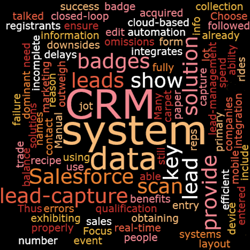|
exhibiting 101
 The Finer Things
Avoid costly missed deadlines and last-minute budget busters by paying attention to the lesser-known rules and provisions found in the fine print of most exhibitor services manuals.
The old adage that "the devil is in the details" applies to many aspects of exhibit marketing, but none more so than the convoluted verbiage and fine print found in exhibitor services manuals, which specify the regulations laid out by the general service contractor (GSC), the venue, the official subcontractors, and the show manager or organizer. These rules vary from show to show, depending on things like the type of facility, the size of the event, and local union contracts.
Most of the guidelines in the exhibitor services manual make perfect sense, and I think we can all get on board with rules dictating things such as the volume of in-booth music and the placement of signs and elements to avoid obstructing sight lines of neighboring exhibitors. That being said, here are topics that are often overlooked but can get you into trouble if you don't adhere to the rules that pertain to them. IAEE Guidelines Most show organizers expect their exhibitors to abide by the International Association of Exhibitions and Events' "Guidelines for Display Rules and Regulations," which govern everything from lighting and electrical to flammable materials and accessibility. Many of these provisions are second nature to seasoned exhibitors, but face-to-face marketing newbies may be left in the dark as to what they entail. Unfortunately, an increasing number of show managers are opting to not include the actual IAEE guidelines in their exhibitor services manuals and instead give them a mere mention in the terms and conditions section of the booth-space contract. For the most recent version of the IAEE guidelines, visit www.iaee.com. Booth-Space Payments Do you know how much time you have from the date you sign your booth-space contract to when your first payment is due? Do you know how late your payment has to be before you've lost not only your contracted booth space but also all the prior payments you've made toward your balance? Not all shows are the same, and some vary greatly on payment percentages (e.g., a 50-percent down payment with two additional 25-percent payments versus a 34-percent down payment followed by two 33-percent payments), the time frame from the date you sign up for space until the first payment is due, the due dates for the subsequent payments, and the amount of your deposit that will be returned if you miss a payment date or cancel your contract. It's important to note that if you decide to pull out of a show after you've already paid for your booth space, there aren't any mitigated damages if show management resells your space. In other words, show management is not obligated to return any money to you unless the contract explicitly dictates it. This means it can keep your money and resell your space to another exhibitor. Commercial Liability Insurance There is nothing wrong with show management asking exhibitors to have a commercial liability policy in place to cover bodily injury or property damage when the insured is legally responsible. But some show managers have figured out that mandating the purchase of a stand-alone corporate liability insurance policy (through a broker with whom they have a relationship) is a revenue generator for the show. The booth-space contract's terms and conditions can insist that an exhibitor purchase insurance in an amount – and from a vendor – designated by show management. I've seen requirements for policies up to $2.5 million that must name the association or organization running the show, the show manager, the show manager's parent company, the GSC, and the venue as additional insured parties. In all likelihood, the show is getting a commission on the premiums of its hamstrung exhibitors, and the insurance company is reporting to show management which exhibitors have purchased policies. Exhibitors that have not purchased the policies may be precluded from even unloading their freight until the insurance requirements are met. Exhibitor-Appointed Contractors Unfortunately, your preferred vendors can't simply stroll onto the show floor and get to work on your exhibit. The exhibitor services manual will explain what documentation is needed to bring in exhibitor-appointed contractors and the deadlines for submitting the forms to show management. EACs will also be responsible for submitting certificates of insurance verifying that they have active policies with sufficient coverage during the show dates. Union Labor Did you know that in some cities, union regulations mandate that exhibitors can't peel the backing off hook-and-loop fastener on a graphic before slapping it on their exhibit wall? In others, they can't plug in their own equipment to a 120-volt power outlet. Factor in various jurisdictions (e.g., having to hire workers from one union to rig your hanging sign and laborers from another to connect it to electrical power), contractual arrangements for the timing and length of breaks, minimum guaranteed hours (e.g., having to pay a laborer for four hours of work when he or she finished the job in one), straight time versus overtime, etc., and you have a potential budgetary and logistical nightmare – if you're not familiar with the regulations specific to each union's contract. Overhead Signs and Banners To hang a sign or banner above your exhibit, you may need the approval of a certified or licensed structural engineer. At numerous exhibit halls, the engineer approving the plans for rigged elements has to be licensed in the state in which the convention center is located and not in the state that the element was designed and/or constructed. After a structural engineer has approved the plans, you must submit the blueprints to show management or the show venue. Also check if your hanging sign has to be shipped to the advance warehouse rather than direct to site, and what the deadlines are for both its arrival and your rigging order forms. Failing to do so can raise your rigging costs to the maximum on-site order rate. Tall Exhibit Structures Don't be surprised if you're required to hire union labor and equipment to tether tall exhibit structures (often higher than 12 feet) to the venue's ceiling. This scenario happens for a number of reasons, such as when the venue is in an earthquake zone, the booth is under an air duct, the exhibit is near freight doors that when opened create a wind-tunnel effect, or the exhibit doesn't appear stable to the on-site structural engineer. If show management says you have to tether, your only options are to shell out the money and tether it or take down the structure or element in question. "Other Duties as Assigned" One of my favorite terms and conditions (usually printed in tiny 4-point font on the back of the booth-space application) is what I call the "Other Duties as Assigned" rule. If your job description has a "garbage clause" that dictates you'll perform any other duties your employer would like to dump on you, you know what I'm talking about. The booth-space rental contract's terms and conditions often have a similar open-ended clause that allows show management to do or change anything it believes is in the best interest of the show at any time, and as an exhibitor, you have no legal recourse. You basically just signed away the farm on this one. Can show management change the dates of the show after you've signed the contract? Yes. Can it change the venue from a high-end resort to a cruise ship? Yes. Can it move your booth anywhere on the show floor and sell your space to someone else? Yes. Not surprisingly, all three of these things have happened to me, and it's tough to explain to your boss why your exhibit is now buried in a remote hall behind a huge support pillar or why the January event you chose specifically to fill a gap in your leads pipeline is now running the same week as your biggest show of the year in February. The bad news is every show has its own quirky rules, and no two shows' or venues' regulations are exactly the same. The good news is that you have access to all of these rules ahead of time and can plan accordingly – just remember to read the fine print. E  Candy Adams
Candy AdamsCTSM, CEM, CMP, CMM "The Booth Mom," is an independent exhibit project manager, trainer, speaker, consultant, and an Exhibitor Conference faculty member. CandyAdams@BoothMom.com
|
|
|
||||||||||||||||||||||||||||
|
|
||||||||||||||||||||||||||||
|
TOPICS Measurement & Budgeting Planning & Execution Marketing & Promotion Events & Venues Personal & Career Exhibits & Experiences International Exhibiting Resources for Rookies Research & Resources |
MAGAZINE Subscribe Today! Renew Subscription Update Address Digital Downloads Newsletters Advertise |
FIND IT Exhibit & Display Producers Products & Services All Companies Get Listed |
EXHIBITORLIVE Sessions Certification Exhibit Hall Exhibit at the Show Registration |
ETRAK Sessions Certification F.A.Q. Registration |
EDUCATION WEEK Overview Sessions Hotel Registration |
CERTIFICATION The Program Steps to Certification Faculty and Staff Enroll in CTSM Submit Quiz Answers My CTSM |
AWARDS Sizzle Awards Exhibit Design Awards Portable/Modular Awards Corporate Event Awards Centers of Excellence |
NEWS Associations/Press Awards Company News International New Products People Shows & Events Venues & Destinations EXHIBITOR News |
||||||||||||||||||||
|
||||||||||||||||||||||||||||






